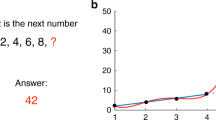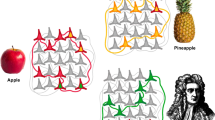Abstract
Biological brains are capable of general learning without supervision. This is learning across multiple domains without interference. Unlike artificial neural networks, in real brains, learned information is not purely encoded in real-valued weights but instead it resides in many neural aspects. Such aspects include, dendritic and axonal morphology, number and location of synapses, synaptic strengths and the internal state of neural components. Natural evolution has come up with extraordinary ‘programs’ for neurons that allow them to build learning systems through group activity. The neuron is the ‘brain within the brain’. We argue that evolving neural developmental programs which when executed continuously build, shape and adjust neural networks is a promising direction for future research. We discuss aspects of neuroscience that are important, and examine a model that incorporates many of these features that has been applied to a number of problems: wumpus world, checkers and maze solving.
Similar content being viewed by others
References
Alberts B, Johnson A, Lewis J, Raff M, Roberts K, Walter P (2002) Molecular biology of the cell. Garland, New York
Astor JC, Adami C (2000) A development model for the evolution of artificial neural networks. Artif Life 6: 189–218
Baum EB (1989) A proposal for more powerful learning algorithms. Neural Comput 1: 201–207
Bliss TVP, Lomo T (1973) Long-lasting potentiation of synaptic transmission in the dentate area of the anesthetized rabbit following stimulation of the perforant path. J Physiol 232: 331–356
Boers EJW, Kuiper H (1992) Biological metaphors and the design of modular neural networks. Master’s thesis. Department of Computer Science and Department of Experimental and Theoretical Psychology, Leiden University
Cangelosi A, Nolfi S, Parisi D (1994) Cell division and migration in a ‘genotype’ for neural networks. Netw Comput Neural Syst 5: 497–515
Chellapilla K, Fogel DB (2001) Evolving an expert checkers playing program without using human expertise. IEEE Trans Evol Comput 5: 422–428
Cooke SF, Bliss TVP (2006) Plasticity in the human central nervous system. Brain 129: 1659–1673
Crick F (1989) The recent excitement about neural networks. Nature 337: 129–132
Dalaert F, Beer R (1994) Towards an evolvable model of development for autonomous agent synthesis. In: Brooks R, Maes P (eds) Proceedings of the fourth conference on artificial life. MIT Press, Cambridge
Debanne D, Daoudal G, Sourdet V, Russier M (2003) Brain plasticity and ion channels. J Physiol (Paris) 97: 403–414
Dekaban AS, Sadowsky D (1978) Changes in brain weights during the span of human life. Ann Neurol 4: 345–356
Dimand RW, Dimand MA (1996) A history of game theory: from the beginnings to 1945, vol 1. Routledge, Urbana
Downing KL (2007) Supplementing evolutionary developmental systems with abstract models of neurogenesis. In: Proceeding conference on genetic and evolutionary computation. ACM, New York, pp 990–996
Fahlman SE, Lebiere C (1990) The cascade-correlation architecture. In: Touretzky DS (eds) Advances in neural information processing systems. Morgan Kaufmann, San Mateo
Federici D (2005) Evolving developing spiking neural networks. In: Proceedings of CEC 2005 IEEE congress on evolutionary computation, pp 543–550
Federico Bermúdez-Rattoni, F (eds) (2007) Neural plasticity and memory from genes to brain imaging. CRC Press, Boca Raton
Fogel D (2002) Blondie24: playing at the edge of AI. Morgan Kaufmann, San Francisco
Frean M (1990) The upstart algorithm: a method for constructing and training feedforward neural networks. Neural Comput 2: 198–209
French RM (1999) Catastrophic forgetting in connectionist networks: causes, consequences and solutions. Trends Cogn Sci 3(4): 128–135
Frey U, Morris R (2002) Synaptic tagging and long-term potentiation. Nature 385(6616): 533–536
Gaiarsa J, Caillard O, Ben-Ari Y (2002) Long-term plasticity at GABAergic and glycinergic synapses: mechanisms and functional significance. Trends Neurosci 25(11): 564–570
Gerstner W, Kistler W (2002) Spiking neuron models. Cambridge University Press, Cambridge
Hebb D (1949) The organization of behavior. Wiley, New York
Hornby G, Lipson H, Pollack JB (2003) Generative representations for the automated design of modular physical robots. IEEE Trans Robot Autom 19: 703–719
Hornby G, Pollack JB (2001) Body-brain co-evolution using L-systems as a generative encoding. In: Proceeding conference on genetic and evolutionary computation, pp 868–875
Irving G, Donkers J, Uiterwijk J (2000) Solving kalah. Int Comput Games Assoc J 23(3): 139–147
Jakobi N (1995) Harnessing morphogenesis, cognitive science research paper 423, cogs. Tech. rep. University of Sussex
Judd S (1988) On the complexity of loading shallow neural networks. J Complex 4: 177–192
Kandel ER, Schwartz JH, Jessell T (2000) Principles of neural science, 4th edn. McGraw-Hill, New York
Kendall G, Whitwell G (2001) An evolutionary approach for the tuning of a chess evaluation function using population dynamics. In: Proceedings of IEEE congress on evolutionary computation (CEC 2001), pp 995–1002
Khan G, Miller J (2009) Evolution of cartesian genetic programs capable of learning. In: Proceeding conference on genetic and evolutionary computation (GECCO), pp 707–714
Khan G, Miller J (2010) Solving mazes using an artificial developmental neuron. In: Proceeding conference on artificial life (ALIFE) XII. MIT Press, Cambridge, pp 241–248
Khan G, Miller J, Halliday D (2007) Coevolution of intelligent agents using cartesian genetic programming. In: Proceeding conference on genetic and evolutionary computation (GECCO), pp 269–276
Khan GM, Miller JF, Halliday DM (2009) In search of intelligent genes: the cartesian genetic programming computational neuron (CGPCN). In: Proceedings of IEEE congress on evolutionary computation. IEEE, Piscataway, pp 574–581
Kitano H (1990) Designing neural networks using genetic algorithms with graph generation system. Complex Syst 4: 461–476
Kleim JA, Lussnig E, Schwartz ER, Comery TA, Greenough WT (1996) Synaptogenesis and fos expression in the motor cortex of the adult rat after motor skill learning. J Neurosci 16: 4529–4535
Kleim JA, Vij K, Ballard DH, Greenough WT (1997) Learning-dependent synaptic modifications in the cerebellar cortex of the adult rat persist for at least four weeks. J Neurosci 17: 717–721
Koch C (1999) Biophysics of computation: information processing in single neurons. Oxford University Press, Oxford
Koza J (1992) Genetic programming: on the programming of computers by means of natural selection. MIT Press, Cambridge
Kumar, S, Bentley, JP (eds) (2003) On growth, form and computers. Academic Press, London
Lindenmeyer A (1968) Mathematical models for cellular interaction in development. Parts I and II. J Theor Biol 18: 280–315
Lubberts A, Miikkulainen R (2001) Co-evolving a go-playing neural network. In: Coevolution: turning adaptive algorithms upon themselves, Birds-of-a-Feather Workshop, genetic and evolutionary computation conference, p 6
Maguire EA, Gadian DG, Johnsrude IS, Good CD, Ashburner J, Frackowiak RSJ, Frith CD (2000) Navigation-related structural change in the hippocampi of taxi drivers. PNAS 97: 4398–4403
McCloskey M, Cohen N (1989) Catastrophic interference in connectionist networks: the sequential learning problem. Psychol Learn Motiv 24: 109–165
McCulloch W, Pitts W (1943) A logical calculus of the ideas immanent in nervous activity. Bull Math Biophys 5: 115–133
Miller JF, Thomson P (2000) Cartesian genetic programming. In: Proceedings of the third European conference on genetic programming. LNCS, vol. 1802. Springer, Berlin, pp 121–132
Moriarty D, Miikulainen R (1995) Discovering complex othello strategies through evolutionary neural networks. Connect Sci 7(3–4): 195–209
Quartz S (1999) The constructivist brain. Trends Cogn Sci 3: 48–57
Quartz S, Sejnowski T (1997) The neural basis of cognitive development: a constructivist manifesto. Behav Brain Sci 20: 537–556
Quinlan PT (1998) Structural change and development in real and artificial networks. Neural Netw 11: 577–599
Quinlan, PT (eds) (2003) Connectionist models of development. Psychology Press, East Sussex
Ratcliff R (1990) Connectionist models of recognition memory: constraints imposed by learning and forgetting functions. Psychol Rev 97: 285–308
Richards N, Moriarty D, Miikkulainen R (1998) Evolving neural networks to play go. In: Bäck T (ed) Proceedings of the seventh international conference on genetic algorithms. Morgan Kaufmann, San Francisco, CA, pp 768–775
Roberts P, Bell C (2002) Spike-timing dependent synaptic plasticity in biological systems. Biol Cybern 87: 392–403
Rose S (2003) The making of memory: from molecules to mind. Vintage, UK
Rust AG, Adams R, Bolouri H (2000) Evolutionary neural topiary: growing and sculpting artificial neurons to order. In: Proceedings of the 7th international conference on the simulation and synthesis of living systems (ALife VII). MIT Press, Cambridge, pp 146–150
Samuel A (1959) Some studies in machine learning using the game of checkers. IBM J Res Dev 3(3): 210–219
Schaeffer J (1996) One jump ahead: challenging human supremacy in checkers. Springer, Berlin
Segal M (2005) Dendritic spines and long-term plasticity. Nat Rev Neurosci 6: 277–284
Shannon C (1950) Programming a computer for playing chess. Phil Mag 41: 256–275
Shepherd GM (1990) The synaptic organization of the brain. Oxford University Press, Oxford
Smythies J (2002) The dynamic neuron. MIT Press, Cambridge
Song S, Miller KD, Abbott LF (2000) Competitive Hebbian learning through spike-timing-dependent synaptic plasticity. Nat Neurosci 3: 919–926
Stanley KO (2007) Compositional pattern producing networks: a novel abstraction of development. Genetic Program Evolvable Mach 8: 131–162
Stanley KO, D’Ambrosio DB, Gauci J (2009) A hypercube-based encoding for evolving large-scale neural networks. Artif Life 15: 185–212
Stanley KO, Miikkulainen R (2002) Competitive coevolution through evolutionary complexification. J Artif Intell Res 21: 63–100
Stanley KO, Miikkulainen R (2002) Evolving neural network through augmenting topologies. Evol Comput 10: 99–127
Stanley KO, Miikkulainen R (2003) A taxonomy for artificial embryogeny. Artif Life 9(2): 93–130
Stuart, G, Spruston, N, Häusser, M (eds) (2008) Dendrites. Oxford University Press, Oxford
Tada T, Sheng M (2006) Molecular mechanisms of dendritic spine morphogenesis. Curr Opin Neurobiol 16: 95–101
Tramontin AD, Brenowitz E (2000) Seasonal plasticity in the adult brain. Trends Neurosci 23: 251–258
Valverde F (1971) Rate and extent of recovery from dark rearing in the visual cortex of the mouse. Brain Res 33: 1–11
Van Ooyen, A (eds) (2003) Modeling neural development. MIT Press, Cambridge
Van Ooyen A, Pelt J (1994) Activity-dependent outgrowth of neurons and overshoot phenomena in developing neural networks. J Theor Biol 167: 27–43
Wee-Chong O, Yew-Jin L (2003) An investigation on piece differential information in co-evolution on games using kalah. In: Proceedings of the 2003 congress on evolutionary computation CEC2003. IEEE Press, Piscataway, pp 1632–1638
Wolpert L, Smith J, Jessell T, Lawrence P, Robertson E, Meyerowitz E (2002) Principles of development, 3rd edn. Oxford University Press, Oxford
Yao X (1999) Evolving artificial neural networks. Proc IEEE 87(9): 1423–1447
Author information
Authors and Affiliations
Corresponding author
Rights and permissions
About this article
Cite this article
Miller, J.F., Khan, G.M. Where is the brain inside the brain?. Memetic Comp. 3, 217–228 (2011). https://doi.org/10.1007/s12293-011-0062-y
Received:
Accepted:
Published:
Issue Date:
DOI: https://doi.org/10.1007/s12293-011-0062-y




